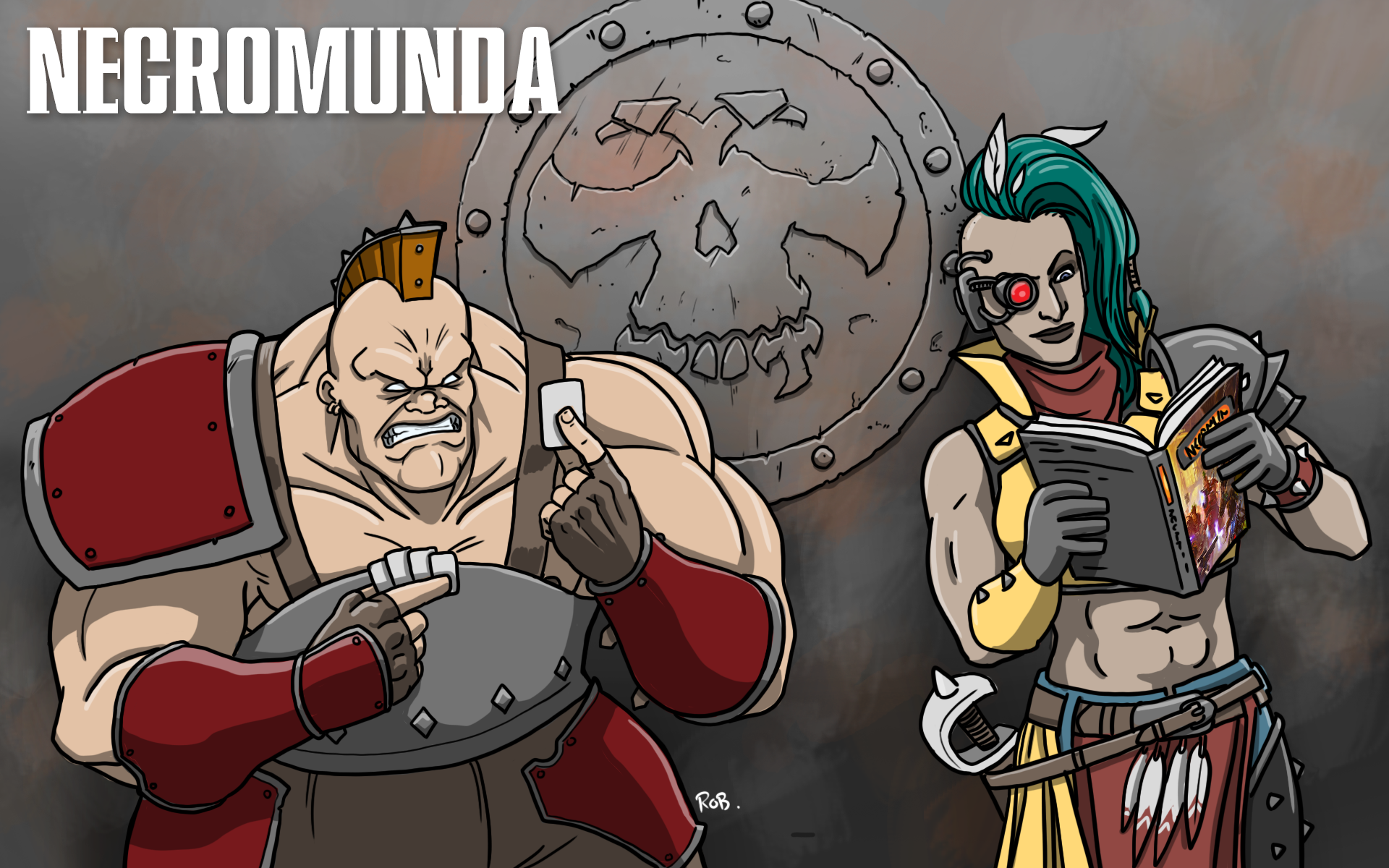Hey scummers! It’s been a few years since we last posted an article on how to start a campaign, so the Goonhammer crew is taking their experience and taking a fresh look at what a new Arbitrator can do to get started. Let’s dive in!
One of the reasons that Necromunda is so much fun to play is because of the RPG elements that are associated with the growth (and death) of the fighters during a campaign. Whether it’s watching a humble Archeotek grow into Crabro, Destroyer of Worlds or cheering as a Cargo-8 plows off the ramp into the head of a Chaos Warhound Titan, campaigns offer a unique opportunity for emergent stories and amazing experiences. In other words, they’re fun as hell. They’re also a lot of work, and it’s easy for a fledgling Arbitrator to be intimidated by the prospect of being the source of fun or despair for a local gaming group. The good news is that with the right guidance and preparation, being an Arbitrator is not terribly difficult and can be immensely rewarding.

Step 1: Scope The Campaign
Every campaign will be a little different, and it’s important to consider the logistics of your campaign when determining what will be played. Here are some questions to ask yourself and your players.
- How many players will be participating?
- What is the skill level of the player base? Are most of the players new? Is there a mix of veterans and newbies? Did you accidentally get volunteered to Arbitrate a campaign full of hardcore Necromunda fanatics?
- What is the schedule and venue? Is this a weekender where you’ll be playing all the games in a short span? A multi-week campaign where players will meet on the same day at a local store? Most campaigns are multiple weeks and have players either meet at their convenience or on the same day at the same venue.
- Have the players indicated a preference for a particular campaign, style of play, or experience?
- What is the terrain situation like? Are you better off doing Ash Wastes because your FLGS has nothing but 40k terrain, or is there some sicko in your group who has a full Sector Mechanicus, Zone Mortalis, and Ash Waste table just lying around?
- What gangs will players likely bring? Do they have vehicles? Is there some sicko in your group who has enough vehicles that everyone could use them?
- How likely is it that every player will stick with the campaign until the very end?
- Why are YOU doing this? What will you do to make sure you’re having fun?
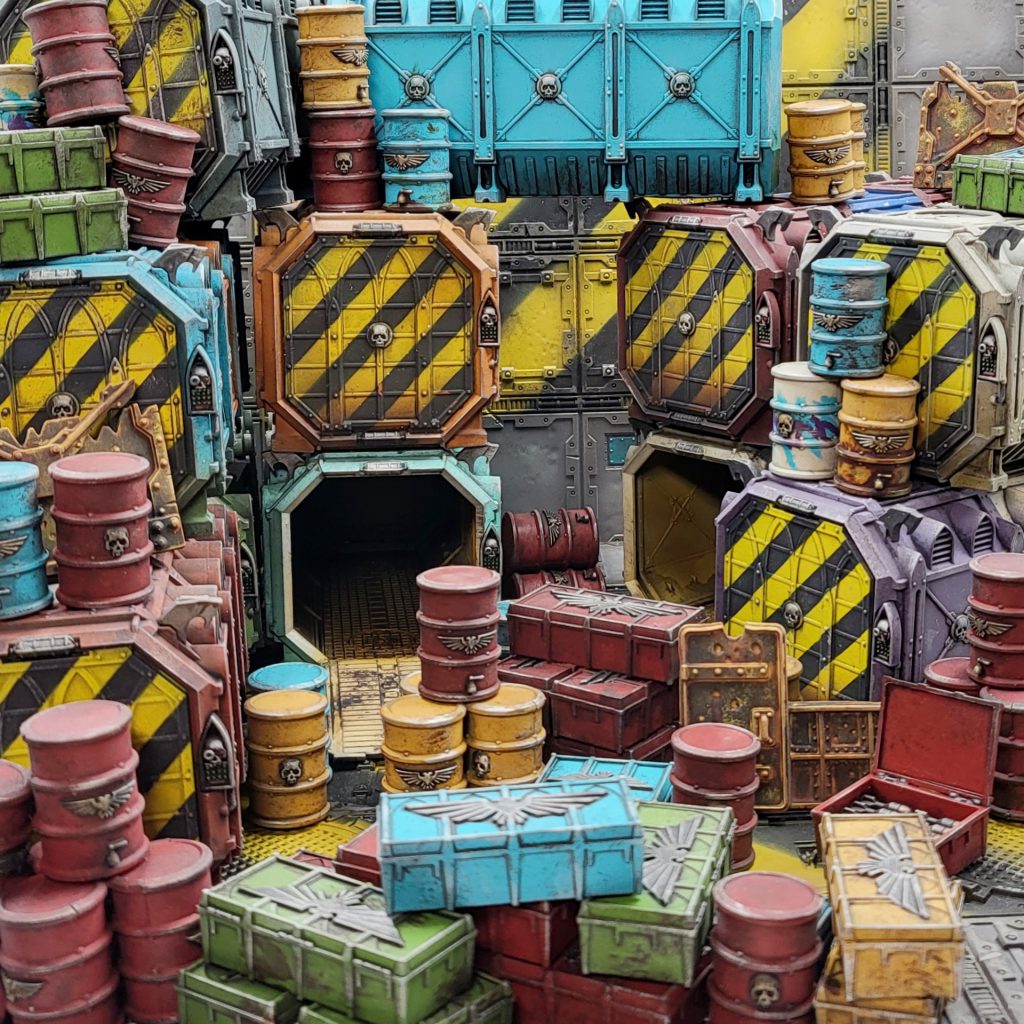
Step 2: Pick Your Vibe
Necromunda is a game that can heavily devolve into feelsbad territory if players have different expectations about how games will go. It’s fairly easy to break the game and it’s important that players understand what kind of vibe the campaign is going for. It’s perfectly okay to have a hardcore campaign where the objective is to make gangs that are as powerful as possible, but everyone needs to be doing that. Otherwise you end up with one player taking a maxed out Goliath Gang with cookie-cutter gene-smithed upgrades, another player taking a Van Saar multi-melta festival, and a third player playing a narratively themed Slave Ogryn rivet gang full of storm welders. One of them is going to have a bad time.
As an Arbitrator, it will fall on you to determine the vibe of the campaign and make sure everyone is on the same page. This is accomplished through a variety of acts such as writing a solid primer, coming up with house rules, reviewing lists for approval, choosing the right campaign structure, determining how tactics cards are implemented, and intervening where necessary to ensure everyone has a good time.
Here are some examples of different campaigns with different vibes:
- The 2024 Goonhammer Open Necromunda Weekender was run by Kevin Fowler and was intentionally designed to be light-hearted and narratively driven. Kevin accomplished this by using a campaign with a lot of house rules and custom modifications, making tactics cards optional, and eliminating recovery so that players could have fun over a compressed schedule.
- The 2023 Goonhammer Open Necrolympics Campaign was run by Primaris Kevin and was intended as a more rigid and straightforward campaign that attempted to make things equitable between players but was still fun. This was accomplished by using a custom campaign where both players received equal revenue, eliminating recovery, using a fixed set of missions and tactics cards that everyone rotated through, and introducing a “Rule of Cool” that rewarded Fighters for doing fun things.
- The Lost Zone campaign was a campaign that Goonhammer put together in 2021 that recreated the destitute, hard-fought experience that older players remember from the original edition of Necromunda released in the 90s.
- Way back in 2020 we dropped a Mini-Munda Campaign which was a quick and dirty system for having brand-new players jump into Skirmish games and get a taste of a campaign.
Spend a moment to put together some ideas to describe what kind of campaign you are going for. Here are some descriptions that could be applied: chill, easy-going, competitive, cut-throat, hardcore, relaxed, narrative, simple, vehicle-driven, anything goes, player-driven, story-driven, minimalist, basic, homebrew, wacky, serious, Arbitrator-driven, equitable, accessible, introductory, veteran, insane. Once you’re done, toss on “fun” at the end because if you’re not having fun then why are you playing a game?
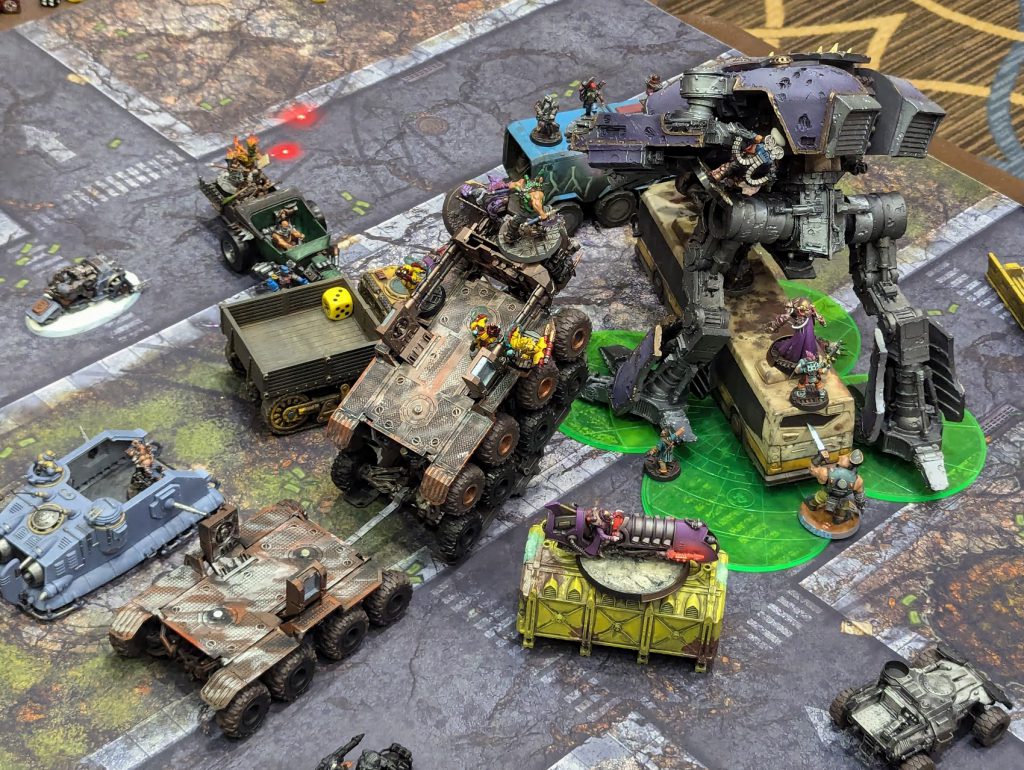
Step 3: Pick Your Campaign
Once you’ve figured out the scope and vibe, now you can choose the core campaign structure. There are several campaigns available through the books. Generally the follow a basic structure of 3 Campaign Cycles, a Downtime, and then 3 more Campaign Cycles. Each campaign will have advantages and disadvantages, particularly when it comes to income generation.
The Dominion Campaign is available in the 2023 Necromunda Core Rulebook and is generally considered the default campaign. The campaign revolves around the acquisition and exploitation of territories, several of which have bonuses linked to specific Houses. Unfortunately the territory system is a bit broken, and features some territories which are absolutely fantastic and others which are a bit trash. It’s going to be more important than an Arbitrator ensures things are balanced, particularly since you could end up in a situation where the Delaque player has a Drinking Hole and Gambling Den and has the option to mess up four opposing Fighters each game. There are several variant campaigns in the rulebook which should definitely be considered. The Escalation Campaign and Classic Campaign look particularly cool.
The Dark Uprising Campaign was originally printed in the Dark Uprising box and then re-printed in the Apocrypha Necromunda book. It’s a thematic campaign revolving around a Chaos-tainted incursion and includes several mechanics that differ from a Dominion campaign. This includes starvation, scavenging, distinct phases (Insurrection and Damnation), no Trading Post, and a fight between Chaos and Order in which different sides can be in Ascendancy. Unfortunately the starvation mechanic might force gangs to eat their own players, which is extremely problematic since snowballing and having losing players quit is one of the biggest challenges of any campaign.
The Law and Misrule Campaign is now one of the oldest campaigns in Necromunda, hailing all the way back from the Book of Judgement from 2019. This is the campaign that introduced the Black Market and the concept of Law-Abiding and Outlaw gangs. It also features the option to use Alliances which bring about powerful bonuses for either Guilder factions or Criminal enterprises such as Cold Traders. It’s an extension of the Dominion campaign with territories called Rackets and they can be just as imbalanced. Where Dominion territories provided bonuses based on which House controlled them, Rackets in Law and Misrule have bonuses linked to other Rackets. Law and Misrule also has Intrigues, which are secret objectives which can provide significant bonuses and make things very interesting for each fight.
The Outlander Campaign from the Book of the Outcast is probably one of the most divergent campaigns out there. Instead of fighting for territories, gangs build up materials and create settlements out of Structures. Over time player settlements will grow and feature things like Fungi Farms, Black Markets, and Walls and Gates to protect everything. This is a campaign that’s probably best suited for a weekender or a convention event, because this campaign is best when players have access to awesome terrain that lets them create chasms and gang forts. The Outlander Campaign is particularly stingy when it comes to handing out credits.
The Succession Campaign is three linked campaigns from three books. Cinderak Burning covers the start of the campaign when Necromunda falls into absolute chaos and the gangs fight over the control of Sympathizers (effectively territories) and declaring allegiances. The campaign has two distinct phases which play very differently, and in the second phase the Sympathizers provide extra credits. Road to Tenemos ditches the Sympathizers and focuses instead on controlling Relics. Relics are objects carried by individual fighters and will provide unique battlefield benefits, but they can also be lost to the other side if the fighter falls. Fall of Helmawr is the third part, and focuses on Waypoints. Waypoints do not have any kind of escalating boons like Law and Misrule Rackets or Dominion Territories, but they all have effects on battles where they are the stake. All three campaigns feature allegiances that provide access to different Dramatis Personae and other benefits. There’s nothing stopping an Arbitrator from using any of these Campaigns on their own, and they can be very fun.
The Ash Wastes Campaign was provided in the Ash Wastes box, and overall it’s a fairly bare-bones campaign where players fight over Road Section that alter battlefield conditions based on how hazardous the location is. Connecting certain Road Sections together creates a Trade Route which provides additional bonuses (generally income), and the campaign includes a map that shows what needs to be controlled. This campaign only works outside and requires everyone to have vehicles or Mounted models, but it could easily be adopted to some kind of Underhive battle.
The Underhells Campaign is from the Book of Desolation, and it features three phases instead of the usual two. Thematically this campaign looks like it’s very cool, but it’s one of the more complicated campaigns out there and includes everything from Data Crystals to Roaming Horrors. This campaign also really needs to have a balance of gangs between Archaeo-hunters and Malstrain gangs. Of all the campaigns this is probably the least accessible for a new Arbitrator, but it’s definitely worth checking out.
What Should You Pick?
For a first campaign, you could choose the Escalation Campaign variant of the Dominion Campaign and set a limit of 250 credits per Cycle instead of 500. This allows everyone to advance at a steady pace, as there is no credit generation from Territories, scenarios, selling equipment or fighters, or “similar mechanics” (which presumably would include the Fixer skill). This mitigates the snowball effect that is typically associated with random income generation influenced by winning or losing a battle, and also minimizes the impact of players playing a different number of games each Campaign Cycle. The Dominion Campaign being in the 2023 Rulebook also means it should be the most accessible.
Using this method means it’s also important to curate the list of territories so that they’re all relatively useful given that income generation no longer occurs. This can be done by making three changes.
- Make it so that every gang gains the Enhanced Boon from controlling a Territory regardless of House.
- Change Rogue Doc Shop and Workshop so that everyone gets the Law-abiding Boon.
- Ditch the following: Old Ruins, Collapsed Dome, Refuse Drift, Corpse Farm, Bone Shrine, Drinking Hole, Gambling Den, Narco Den, Smelting Works, and Mine Workings. These Territories only generate income.

Step 3: Pick Your Rules
There’s no easy way to say this; the Necromunda core rules are a bit of a mess and every campaign can benefit from making some adjustments.
Useful House Rules
In addition to the Optional Rules above, there are several House Rules that we have found to be particularly useful. Many of these rules address deficiencies in the rules that seem obviously terrible (like Melta bombs not actually being able to use the Melta rule), while others are intended as Quality of Life improvements based on pretty obvious issues with the rules.
Injury Rolls: The rules state that if an Injury roll produces more than one Out of Action result, the player is supposed to make a Lasting Injury roll for each result. This is not fun and can make things like melta weapons horribly evil. We recommend making a house rule that Fighters only have to roll once on the Lasting Injury Table whenever they are taken Out of Action.
Custom Vehicles: Custom vehicles are awesome, but when compared to the stock vehicles they pay a massive premium. They also are twice as expensive to repair due to the Jury-rigged rule. We recommend disregarding the Jury-rigged rule entirely.
Shields: The rules for the armour section state that a model can only carry one set of armour unless an exception is listed in the rules. No exception is given for ceramite shields or scrap shields, but a Hrystar Energy Shield can be layered with armour because it is a weapon. We recommend fighters to be allowed to be equipped with shields in addition to a suit of armour.
Melta Bombs: Melta bombs are Grenades, which by definition means they have no Short Range. The Melta trait only triggers at Short Range, so we recommend allowing the Melta trait to function at Long Range for this weapon.
Limited Ammo: When a weapon fails an Ammo Check for one of its profiles, it’s considered to have failed an Ammo Check for all of its profiles. That means that Scarce and Limited can be triggered, which is dumb. We recommend house ruling that failing an Ammo Check on one of a weapon’s profiles does not trigger Scarce or Limited on its other profiles.
Chaos Spawn: Seismic weapons force everyone to be pinned when hit, even fighters who normally ignore being pinned. Spawn literally cannot stand up (it’s not an action they can perform), so we recommend ruling that Spawn cannot be pinned no matter what happens to them.
Versatile: The rules regarding Versatile weapons are a bit odd, particularly in terms of what can and can’t be used when a fighter engages another fighter with them. We recommend ruling that when attacking with a Versatile weapon, only weapons that are within range of the target fighter can be used.
Common Items: Technically an Outlaw gang can’t purchase a Common item on the Trading Post without going through hell. While technically it also applies in reverse, missing out on lho sticks is a lot less damaging than missing out on mesh armour. To remedy this we recommend a house rule that Common items for the Trading Post and Black Market may be purchased without having to send a fighter to visit.
Nobody Dies Week 1: We experimented with variations of this rule in a number of our campaigns. The first week tends to be a learning game for many players. You may consider some combination of “no recovery / nobody dies” if your campaign has a critical mass of first-timers. Merciful arbitrators may also offer Resurrection Packages for lost gangers beyond week one. Nothing like a revenant Escher on a quest for an Orlock Road Captain’s head!
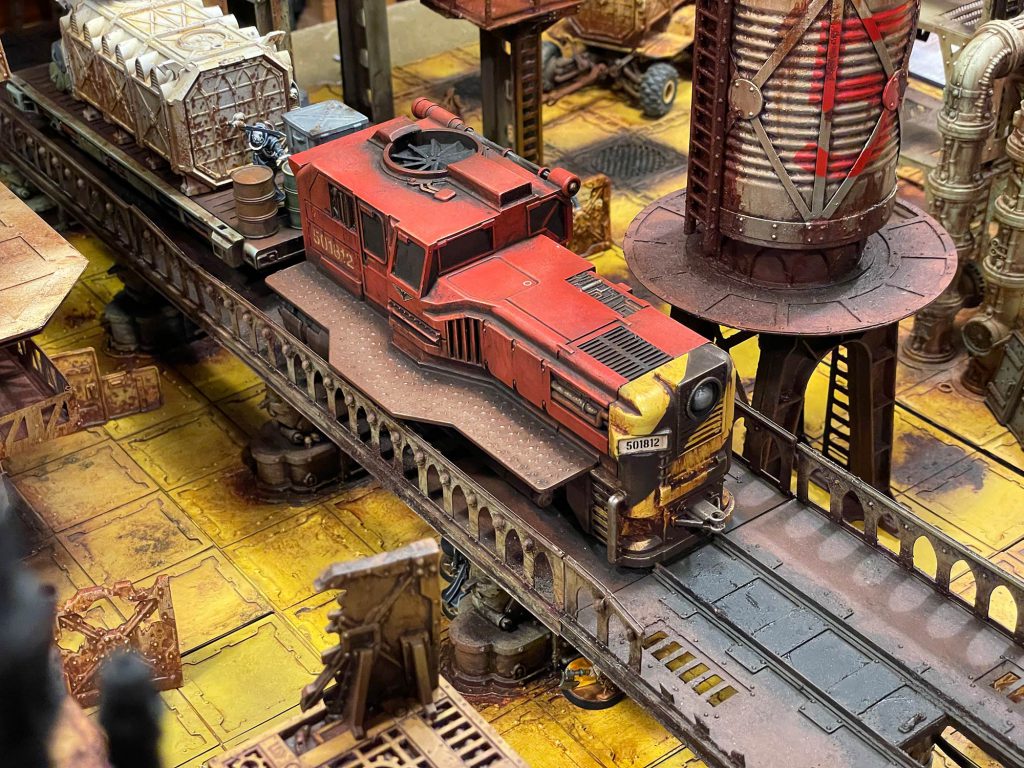
Tactics Cards
Tactics Cards are possibly one of the most awesome, divisive, and frustrating parts of Necromunda. At face value they seem awesome; cool cards that let you turn the tide of a fight with an interesting twist of fate or a sudden case of arson. The downside is that there are an insane number of them, several cards are outright broken, and relying on physical cards which include many that are out of print imbalances an already imbalanced game. Fortunately there are some ways that an Arbitrator can address this.
We highly recommend that you check out our Tactics Card article, which covers every single card and ranks them.
Consider a Ban List
In our experience there are two cards which are simply not fun to play against and should not be used; History of Violence and Dangerous Footing. History of Violence is the equivalent of the Delaque Drinking Hole that unilaterally prevents a fighter from playing. It’s not fun to face something that a game-warping effect with no counter. Dangerous Footing at least requires an Initiative check to cause a fighter to go Out of Action, but it’s still incredibly obnoxious.
Method 1: No Cards
There’s nothing wrong with simply declaring that Tactics Cards won’t be used. Many players don’t use them or forget they exist. If you use this option, it’s important as an Arbitrator to find an alternative means of helping the Underdog who was otherwise counting on those 10 extra Tactics Cards to make up for losing every game since the start of the Succession Campaign.
Method 2: The Goonhammer Method
This method has been successfully used for many campaigns, and is featured on the article linked previously. Every player builds a deck (or list) of 12 cards of their choice and generates cards from that list. Games with random card draw simply randomly pull from that list, while games with player choice randomly draw the specified number of cards, draw one more, and then the player discards one card of their choice. This allows players to feel a sense of agency and not necessarily get screwed by random card draw. There are a few variants to this option.
- Pick an additional six cards; 2 for each environment (Zone Mortalis, Sector Mechanicus, and Ash Wastes) and add the two that are relevant to the mission to the original deck of 12 to make a total of 14 cards to choose from.
- Put restrictions on what cards can be chosen. This can either be done by limiting the source (for example, requiring 50% of the cards to come from cards unique to the gang) or imposing restrictions on how many can be taken from each tier.
Method 3: The Fixed List
This method was used in the 2023 Goonhammer Open, where the goal was to keep things simple and accessible. Rather than have the players select their own Tactics Cards, Primaris Kevin provided a list of 12 tactics that were curated from the tier list. Each Tactics Card was given a name appropriate to the Necrolympics theme (Cool Runnings), being in Baltimore (Challenge Pissing), or because Kevin thought it was funny (He Stashed That Where?). This method ensures everyone is on an equal footing and is particularly good for events where not every player might be fully prepared with a personal card list.
- Using the existing cards as inspiration for custom cards helps ensure a fairly even power level, and helps ensure that there are no bad options. To help with this further, Kevin made sure that situational cards provided a bonus if they weren’t used.
- You don’t have to use custom cards, you can just create a curated list that you think will work best for the event.
- A variant of this approach is to use a list of Tactics Cards that is never randomly selected from. Instead every player always selects the first card on the list, then the second, and so forth. In order for this approach to work the missions have to have a rule that provides a set number of Tactics Cards based on the difference in gang rating, such as an extra card for every 100 credits difference. The idea is to make the cards more and more powerful as the list goes on, until the final card is something egregious like Dangerous Footing. This option can be used as a way to help an Underdog against a seriously overpowered opponent, as there’s only so many Hive Scum you fit use to patch a 1000 credit difference.
Optional Rules
The 2023 Necromunda Core Rulebook includes several optional rules that can change how the game is played. These rules are best-suited for experienced players that are looking for tweaks to some of the combat systems.
Exploding Weapons will dramatically alter the campaign, with a 1 in 36 chance of every Ammo test causing the gun to explode and hurt the bearer. This is really appropriate for a low-tech campaign where the players are scavenging for loot, but it will force players to be more careful about what weapons they field and which models should carry that multi-melta. We don’t recommend this rule for new campaigns.
Unreliable Weapons changes the rules so that instead of rolling a Firepower dice, a natural 6 on any Hit roll requires an Ammo test to be made. Weapons which don’t make a hit roll, like Template weapons, roll a D6 and the Ammo test is made on a 6. This doesn’t actually change the probability for single shot weapons, but when combined with Hail of Bullets below can cause a serious shift in how reliable Rapid Fire weapons are.
Hail of Bullets only really works when the Unreliable Weapons rule is used, and it only applies to Rapid Fire weapons. When firing a Rapid Fire weapon, players can either fire a single shot or a sustained burst. Single shot acts as you would expect, but with a sustained burst you roll a number of Firepower dice equal to the Rapid Fire trait of the weapon and then roll a hit roll for each shot. This means that when combined with Unreliable Weapons the chances of having to make an Ammo test are higher, but in exchange Rapid Fire weapons become far less variable since you’re no longer rolling a single hit roll for multiple shots. This also makes Stray Shots way more likely.
Wild Grenades and Shells makes Grenades and Blast weapons less accurate, helping mitigate the risk of a Van Saar sniping someone with a multi-melta. Ranged attacks always have to target a point (instead of a Fighter), but do not make a hit roll. Instead the player rolls a D6 and a Scatter die. If the Scatter die is a Hit, the Blast marker stays still. If the Scatter die is an arrow, the marker moves a number of inches equal to the D6 roll plus the fighter’s BS. So that Van Saar Prime with the 2+ BS will always scatter at least 3”. If the Scatter die is a Hit and the d6 roll is a 1, something Very Bad has happened and you roll on a helpful table to see how screwed you are.

Step 4: Determine the Missions
Missions can make or break a game of Necromunda, and as Arbitrator it’s up to you to decide if players will choose certain missions or go for a free for all effect. Most of the campaigns have a core set of missions that are available, such as the ones available in the Dominion Campaign, but there are many others available. At organized events such as the Goonhammer Open we tend to give players their missions, either in the form of a primer packet linked to certain tables or by revealing them once matchups are revealed.
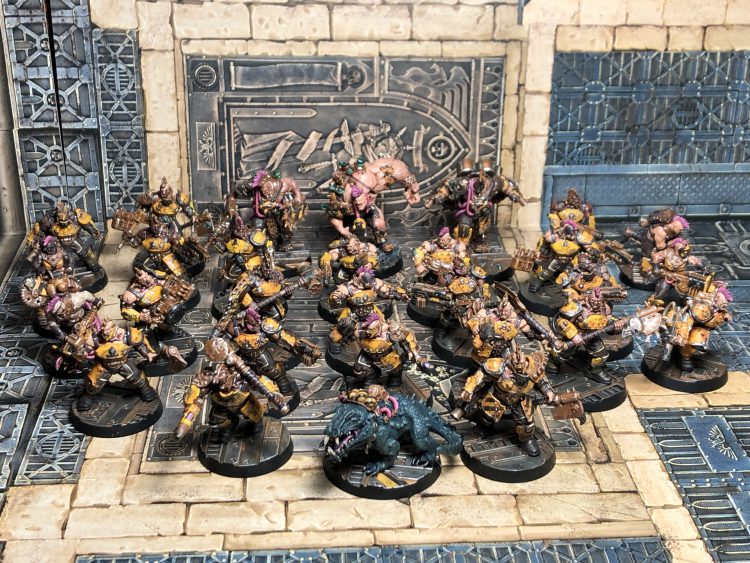
Step 5: Set the Schedule and Matchups
Most of the campaigns utilize an accessible structure where you have 3 Campaign Cycles, a Downtime period, and then another 3 Campaign Cycles. The length of a Campaign Cycle is up to you and could be a single game during the course of a Weekender, one or two weeks, or possibly a month. If possible, establish a set day for everyone to get together and play so that the energy is high. Another other thing to consider is how many games players are permitted each Campaign Cycle and if matchups will be determined between players or through a schedule set by the Arbitrator. Generally for campaigns that aren’t an event it’s a good idea to let players work things out, possibly with some kind of incentive for playing new opponents. Finally, determine how many games players will be allowed to play each Cycle and how you will prevent players from snowballing. This is one of the reasons why the Escalation variant works so well if you set the income to a fixed amount each Campaign Cycle.
Optional House Rule: Campaign Cycle Recovery
In Campaign play, a fighter who goes into Recovery cannot take part in the gang’s next battle. The impact of this can vary wildly depending on how many games a player has each Campaign Cycle, and losing access to their core fighters can make it difficult for a player to want to keep playing. At the GHO we changed the rule so that fighters in Recovery will be available in the next Campaign Cycle. This rule can also apply to a longer campaign where Campaign Cycles last for a week or more and help reduce snowballing; as fighters go into Recovery the player has fewer fighters to play in subsequent games that Campaign Cycle.
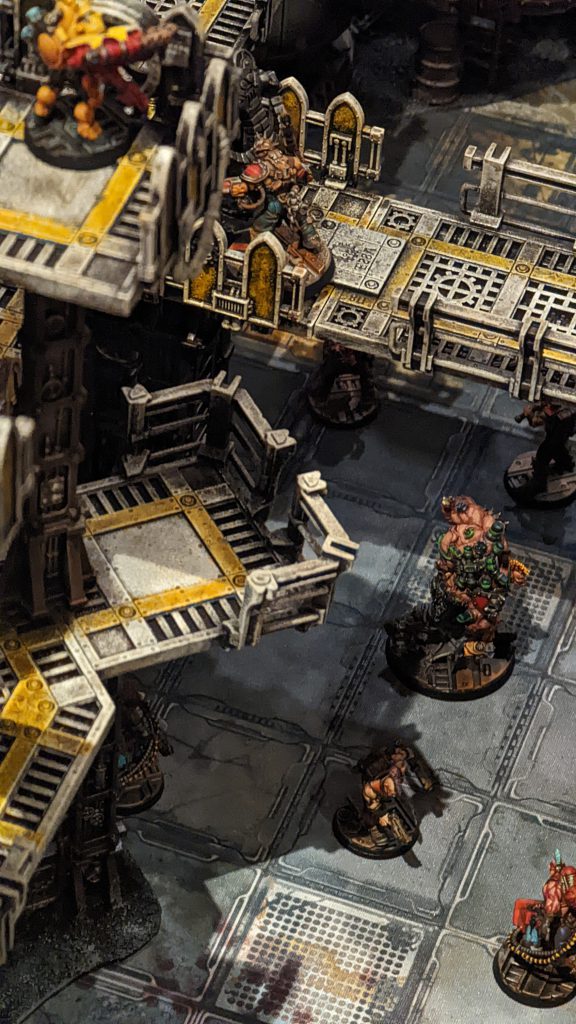
Step 6: Write a Primer!
Let’s be honest here; players generally don’t pay attention to things. We are hard of hearing, our memories are selective at best, and we are barely literate when it comes to actual rules. For the sake of your own sanity and maximizing the probability of consistency, it is in your best interest to write a primer. It doesn’t have to be particularly intricate or beautifully formatted in a manner reminiscent of a GW product, but it should clearly communicate everything that you decided from this article.
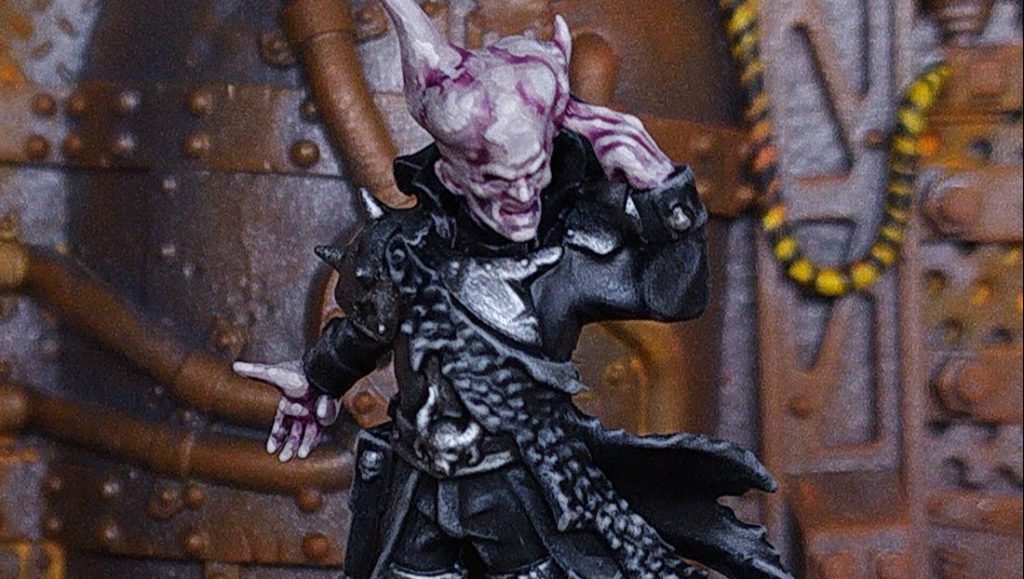
Step 7: Get Feedback!
Once everything is written down and ready to go, share the Primer with your players and get a sense of what they think. Perhaps the consensus is that Tactics Cards are terrible, or that your House Rule making multi-meltas free is amazing and they can’t wait to customize their own fighter. More likely they’ll provide some useful feedback that will help you address things you might have missed and make a better outcome in the end. Getting players involved at this stage also gives them a sense of agency and keeps them more invested in the campaign.
Thanks for reading! We would love to know your own thoughts on what makes a good campaign, so either let us know in the comments below or drop us a line at contact@goonhammer.com!
